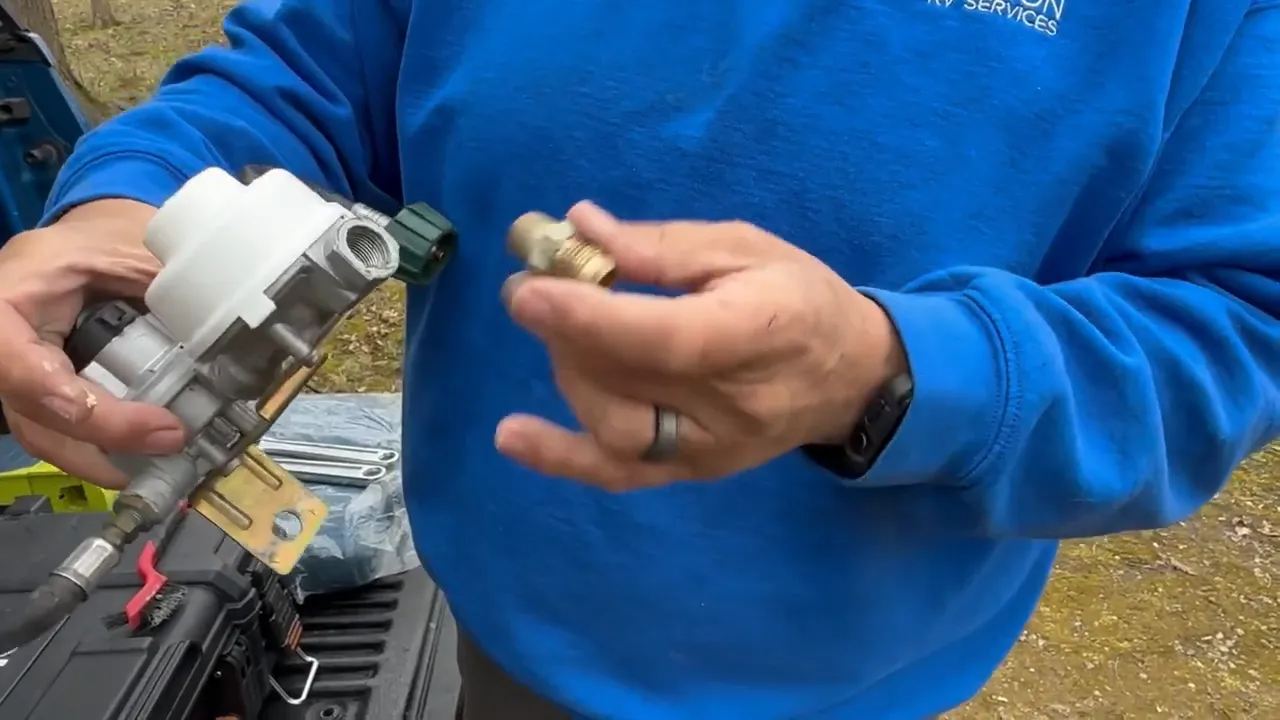To install a two-stage propane regulator, first, turn off the propane supply. Then, connect the regulator to the tank and tighten the connection securely.
Understanding The Importance Of Using A Two Stage Propane Regulator
When it comes to propane-powered appliances, safety is crucial. One of the key components in ensuring safe and efficient operation is a two stage propane regulator. This device plays a vital role in maintaining a consistent gas flow to your appliances, preventing fluctuations in pressure and ensuring a seamless performance. Understanding the importance of using a two stage propane regulator can help you make informed decisions when it comes to maintaining your propane system.
Benefits of using a two stage propane regulator
Using a two stage propane regulator offers several benefits that contribute to the overall performance and safety of your propane system. Here are some key advantages:
- Pressure regulation: A two stage propane regulator helps maintain a steady and controlled pressure throughout your propane system. This is especially important when operating multiple propane appliances, as it ensures each appliance receives an appropriate amount of gas pressure for optimal performance.
- Smooth operation: By preventing pressure fluctuations, a two stage propane regulator ensures a consistent gas flow to your appliances. This results in smooth and uninterrupted operation, reducing the risk of equipment damage or malfunction.
- Enhanced safety: Consistent pressure regulation provided by a two stage propane regulator helps prevent over-pressurization of your propane system. This reduces the risk of leaks, explosions, or other hazardous situations, ensuring the safety of you and your property.
- Extended appliance lifespan: The stable and consistent gas flow delivered by a two stage propane regulator can help prolong the lifespan of your propane appliances. By eliminating pressure surges or drops, it minimizes the stress placed on the appliances, allowing them to operate at their optimal efficiency for longer periods.
- Greater efficiency: Using a two stage propane regulator optimizes the fuel efficiency of your propane appliances. By maintaining a consistent pressure, it ensures that the correct amount of propane is delivered, preventing waste and potentially lowering your energy costs.
How it works to ensure a consistent gas flow
A two stage propane regulator utilizes two internal pressure stages to ensure a consistent gas flow throughout your propane system. Here’s a simplified breakdown of how it works:
| Stage 1 | Stage 2 |
|---|---|
| Receives high-pressure propane from the source | Reduces the pressure to a safe and usable level |
| Maintains a constant pressure | Further reduces the pressure to the desired level for your appliances |
This two-stage process allows the regulator to regulate the pressure more accurately and precisely, resulting in a consistent gas flow. By effectively managing the pressure, a two stage propane regulator ensures that each propane appliance in your system receives a steady supply of propane at the proper pressure, enhancing performance and safety.
Installing a two stage propane regulator may seem intimidating, but with the right guidance and a basic understanding of its importance, you can ensure a smooth and successful installation process. By prioritizing safety and efficiency, you can enjoy the full benefits of using a two stage propane regulator in your propane system.
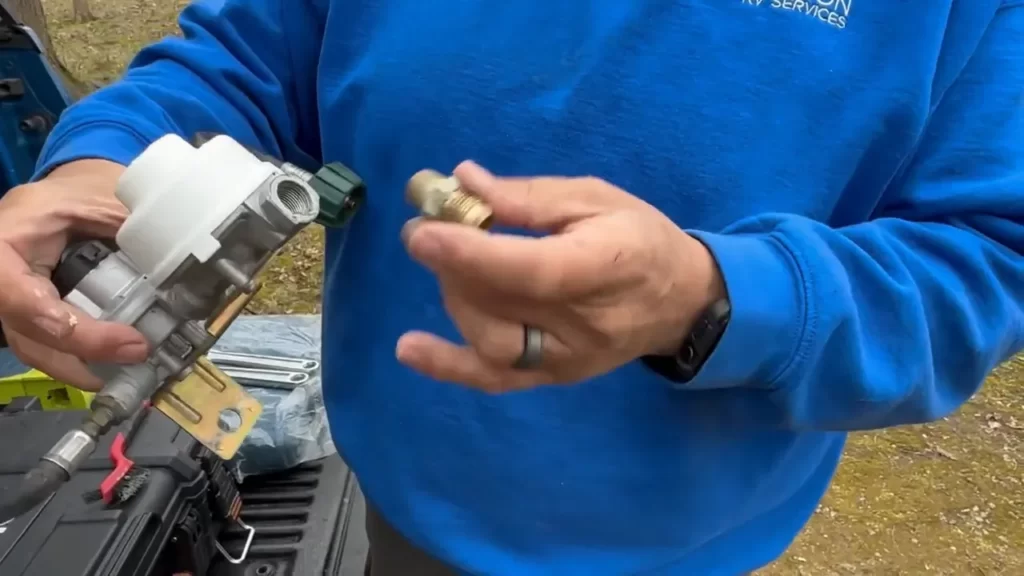
Tools And Materials Needed For The Installation
Before you begin installing a two-stage propane regulator, it’s important to gather all the necessary tools and materials. Having everything prepared will help ensure a smooth and successful installation process. In this section, we will provide you with a comprehensive list of tools and materials needed for the installation.
List of necessary tools
- Adjustable wrench: You’ll need an adjustable wrench to tighten and loosen various connections during the installation process.
- Pipe wrench: A pipe wrench will come in handy for fastening and removing pipes and fittings.
- Teflon tape: Teflon tape is used to provide a tight seal on threaded connections, helping to prevent leaks.
- Hacksaw or pipe cutter: Depending on the existing propane line setup, either a hacksaw or a pipe cutter will be necessary to cut and resize the propane line.
- Measuring tape: A measuring tape will be useful for accurately measuring the length of the propane line during the installation process.
- Screwdriver: A screwdriver is required for opening and closing screw-type hose clamps and tightening screws on the regulator.
- Leak detection solution: To ensure there are no leaks, a leak detection solution is necessary to test the connections and fittings.
- If available:
- Safety glasses
- Gloves
- Flashlight
- Bucket or container to catch any propane drips or spills
- Brush or rag for cleaning the pipes
Required materials for a successful installation
- Two-stage propane regulator: The central component of the installation, a two-stage propane regulator is responsible for reducing the pressure from the propane tank and delivering a steady flow of gas to your appliances.
- Propane hose: A propane hose is needed to connect the regulator to the propane tank.
- Pipe fittings: Depending on the existing setup, you may need various pipe fittings such as elbows, tees, and couplings to ensure proper connections and routing.
- Propane pipe: If the existing propane pipe is not the correct size or needs replacement, you will need to purchase the appropriate length of propane pipe.
- Clamps: Hose clamps will be required to secure the connections between the propane hose and the regulator.
- Propane leak detector: A propane leak detector is an essential tool to test for any potential gas leaks during and after the installation.
- Teflon tape: Teflon tape is necessary to provide a secure and leak-free seal on threaded connections.
- Propane tank: Of course, you will need a propane tank that is suitable for your needs and compliant with local regulations.
By gathering the listed tools and materials, you will be well-prepared to tackle the installation of a two-stage propane regulator. Remember to take all necessary safety precautions and consult the manufacturer’s instructions for any specific requirements related to your regulator model.
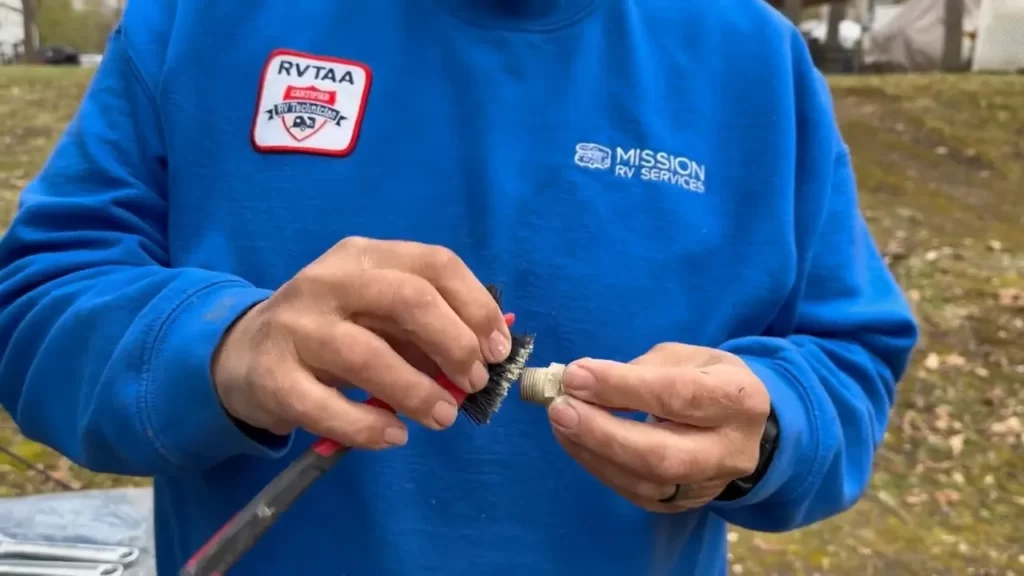
Step-By-Step Instructions For Installing A Two Stage Propane Regulator
Installing a two stage propane regulator is an essential step in ensuring the safe and efficient operation of your propane system. In this guide, we will walk you through the process of installing a two stage propane regulator step-by-step. From shutting off the propane supply to testing the regulator, we’ve got you covered.
Shutting off the propane supply
Before beginning any work on your propane system, it is crucial to shut off the propane supply. This can be done by closing the valve on the propane tank itself. It is important to follow all safety precautions and guidelines provided by your propane supplier when working with propane.
Removing the old regulator
Once the propane supply has been shut off, it is time to remove the old regulator. This can usually be done by unscrewing the regulator from the propane tank using an adjustable wrench. Make sure to hold on to the regulator firmly while unscrewing it to prevent any damage or leaks.
Checking for any leaks and addressing them
After removing the old regulator, it is crucial to check for any leaks in the propane system. One way to do this is by applying a soapy solution to the connections and looking for any bubbles, which indicate a leak. If a leak is detected, it must be addressed and fixed before proceeding with the installation of the new regulator.
Attaching the new two stage propane regulator
Now that any leaks have been addressed, it is time to attach the new two stage propane regulator. Start by ensuring that the threads on the regulator and the propane tank are clean and free from debris. Then, align the threads and screw the regulator onto the propane tank. Use an adjustable wrench to secure the connection, but be careful not to overtighten it.
Testing the regulator and ensuring proper function
Once the new regulator is securely attached, it is important to test it to ensure proper function. To do this, open the valve on the propane tank slowly and listen for any hissing sounds, which may indicate a leak. Then, check all the connections for any signs of leaks using the soapy solution method mentioned earlier. Finally, light a burner on an appliance that uses propane and make sure it ignites and burns evenly. If any issues are detected, it is crucial to address them before using your propane system.
Following these step-by-step instructions will help you successfully install a two stage propane regulator for your propane system. It is always recommended to consult the manufacturer’s instructions and guidelines specific to your equipment for detailed installation steps and safety precautions.
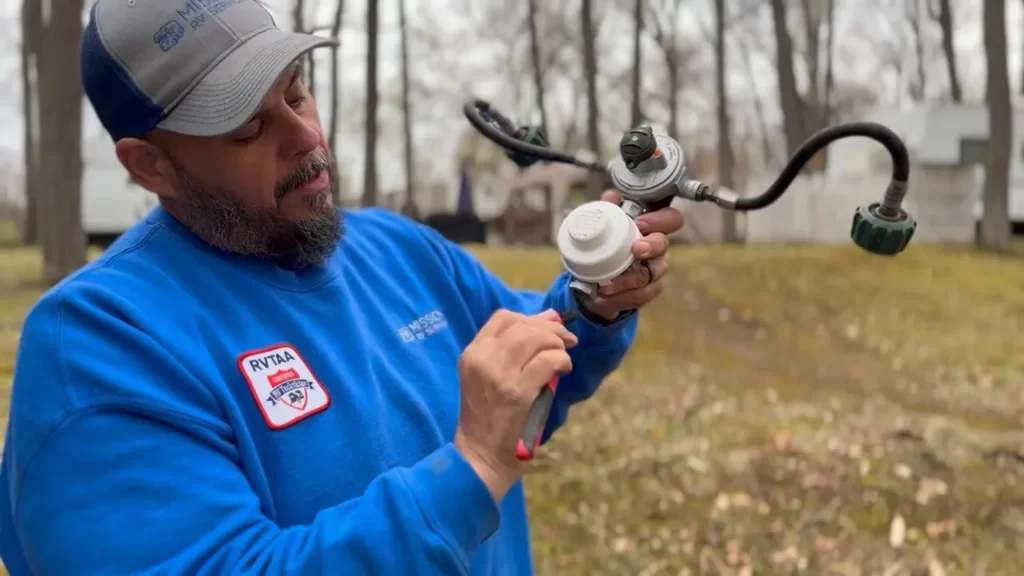
Safety Precautions To Consider During The Installation Process
When it comes to installing a two-stage propane regulator, safety should always be the top priority. Propane gas is highly flammable, so taking the necessary precautions is crucial to ensure a smooth and safe installation process. In this section, we will discuss three important safety measures that you should consider during the installation process. These include working in a well-ventilated area, using appropriate safety gear and equipment, and being cautious when handling propane connections. Let’s delve into each of these safety precautions in detail:
Importance of working in a well-ventilated area
One of the key safety measures that you should adhere to during the installation process is to work in a well-ventilated area. Propane gas can be hazardous if there is not enough air circulation. Ensure that the installation space is well-ventilated by opening windows or doors to allow fresh air to flow. This will help dissipate any potential propane leaks and prevent the accumulation of gas fumes. Ventilation is especially important when working in confined spaces such as basements or small utility rooms.
Using appropriate safety gear and equipment
To further enhance safety during the installation process, it is important to use appropriate safety gear and equipment. This includes wearing gloves, safety goggles, and protective clothing to shield yourself from potential injuries. Additionally, it is recommended to have a fire extinguisher nearby in case of emergencies. Always keep in mind that prevention is better than cure, and using the right safety gear can significantly reduce the risk of accidents or injuries.
Being cautious when handling propane connections
Propane connections should be handled with utmost caution to avoid any potential leaks or accidents. When working with propane, ensure that all connections are tight and secure. Use a propane leak detector solution to check for any leaks before and after making connections. Additionally, refrain from using open flames or smoking during the installation process. It is essential to be mindful of the inherent risks associated with propane gas and take appropriate measures to prevent any mishaps.
By following these safety precautions, you can ensure a safe and successful installation of a two-stage propane regulator. Remember that safety should never be compromised when working with propane gas, and it is always better to be overly cautious than to regret not taking the necessary safety measures.
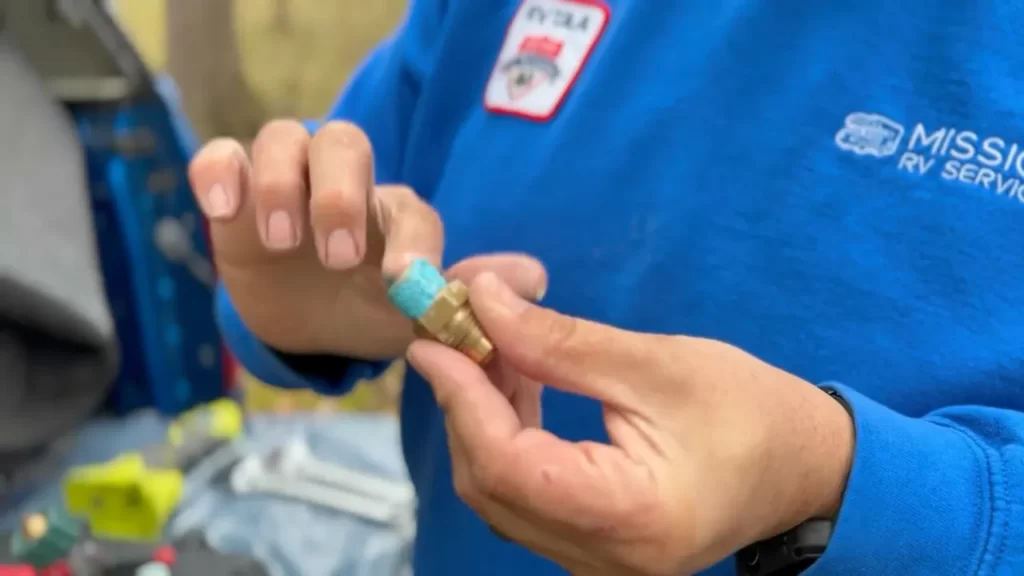
Troubleshooting Common Issues With Two Stage Propane Regulators
Two stage propane regulators are essential for safely managing the flow of propane gas in your home or recreational vehicle. However, like any mechanical device, they can experience common issues that may affect their performance. In this section, we will identify these common problems and provide you with detailed steps to resolve them, ensuring your two stage propane regulator operates efficiently.
Identifying common problems
Before diving into troubleshooting, it’s important to be able to identify common problems with your two stage propane regulator. By recognizing these issues, you can take the necessary steps to fix them promptly. Here are several common problems you may encounter:
| Problem | Symptom |
|---|---|
| Low gas pressure | Appliances not operating at full capacity |
| Leak | Smell of gas or hissing noise |
| Freezing | Frost forming on the regulator |
| Obstruction | No gas flow or reduced gas flow |
Steps to resolve issues such as low gas pressure or leaks
- Step 1: Check for leaks. Use a solution of soapy water to apply on the connections and hoses. If you observe bubbles forming, there is a leak.
- Step 2: Tighten the connections. Using a wrench, ensure all connections are secure, but be careful not to overtighten.
- Step 3: Replace faulty parts. If you identify a damaged hose or fitting, obtain a replacement from a reputable supplier and follow the manufacturer’s instructions for installation.
- Step 4: Adjust the pressure. If you are experiencing low gas pressure, the regulator may need adjustment. Refer to the regulator’s manual for specific instructions on how to adjust the pressure to the appropriate level.
- Step 5: Insulate the regulator. To prevent freezing in cold temperatures, consider using insulation around the regulator to maintain proper functioning.
By following these steps, you can effectively troubleshoot common issues associated with two stage propane regulators. Remember to always prioritize safety and consult a professional if you are unsure about any aspect of the troubleshooting process. With a well-functioning two stage propane regulator, you can enjoy the benefits of propane gas without any disruptions.
Maintenance Tips To Prolong The Lifespan Of A Two Stage Propane Regulator
In order to ensure your two-stage propane regulator functions optimally and has a long lifespan, regular maintenance is key. By following a few simple maintenance tips, you can keep your regulator in top condition and avoid costly repairs or replacements. In this section, we will discuss three important maintenance tips to prolong the lifespan of your two-stage propane regulator.
Cleaning and Inspecting the Regulator Regularly
Cleaning and inspecting your two-stage propane regulator regularly is essential to maintain its performance and longevity. Over time, dirt, dust, and debris can accumulate and affect its functionality. Follow the steps below to clean and inspect your regulator:
- Turn off the propane supply and disconnect the regulator from the propane tank.
- Using a soft brush or cloth, gently remove any visible dirt or debris from the regulator.
- Inspect the regulator for any signs of damage or wear, such as cracks, leaks, or loose fittings.
- If you notice any issues, contact a professional technician to address the problem immediately.
Replacing Worn-Out Parts as Needed
Over time, certain parts of your two-stage propane regulator may become worn out and need replacement. Regularly checking and replacing these parts is crucial to ensure the proper functioning of your regulator. Here are the steps to follow:
- Refer to the manufacturer’s instructions or consult a professional technician to identify the parts that need replacement.
- Obtain the necessary replacement parts from a reputable source.
- Turn off the propane supply and disconnect the regulator from the propane tank.
- Carefully remove the worn-out parts and replace them with the new ones.
- Reconnect the regulator to the propane tank and test its functionality.
Proper Storage During Periods of Non-Use
When your two-stage propane regulator is not in use for an extended period, proper storage is essential to safeguard its lifespan. Follow these guidelines to ensure your regulator is stored correctly:
- Disconnect the regulator from the propane tank.
- Clean the regulator thoroughly to remove any dirt or debris.
- Inspect the regulator for any signs of damage.
- Store the regulator in a cool, dry place away from direct sunlight and extreme temperatures.
- Consider using a protective cover or case to prevent dust and moisture from accumulating on the regulator.
Following these maintenance tips will help you prolong the lifespan of your two-stage propane regulator and ensure safe and efficient operation. Remember to consult the manufacturer’s instructions or seek professional assistance whenever necessary to ensure proper maintenance and care.
Frequently Asked Questions
Why Do I Need A Two-Stage Propane Regulator?
A two-stage propane regulator ensures a consistent and steady flow of propane to your devices. It helps regulate the pressure, ensuring safe and efficient operation. Without it, fluctuations in pressure can cause issues like uneven heating or poor performance.
How Do You Install A 2 Stage Propane Regulator On An Rv?
To install a 2 stage propane regulator on an RV, first, ensure the propane supply is turned off. Disconnect the old regulator and attach the new one, ensuring the arrow on the regulator points toward the RV. Tighten the connections using a wrench.
Test for leaks using soapy water, then turn on the propane supply.
How Does A Second Stage Propane Regulator Work?
A second stage propane regulator reduces the high pressure from the first stage regulator to a lower pressure suitable for appliances. It ensures a steady and consistent flow of propane gas for efficient operation. By regulating the pressure, it prevents damage to appliances and enhances safety during propane usage.
What Is The Difference Between A Single-Stage And A Two-Stage Propane Regulator?
A single-stage propane regulator has one pressure-setting mechanism, while a two-stage regulator has two. Single-stage regulators are ideal for low-demand applications, while two-stage regulators provide a more consistent and precise flow of propane, making them suitable for high-demand and fluctuating pressure needs.
Conclusion
Installing a two-stage propane regulator is a crucial step in ensuring the safe and efficient operation of your propane system. With the step-by-step guide provided in this blog post, you can confidently tackle this installation yourself. By properly regulating the propane pressure, you can maximize the performance and longevity of your propane appliances.
Remember to always follow the manufacturer’s instructions and local regulations when installing or working with propane equipment. Happy installing!
